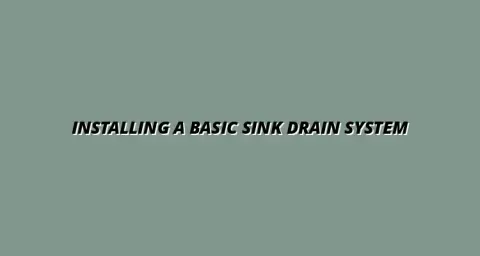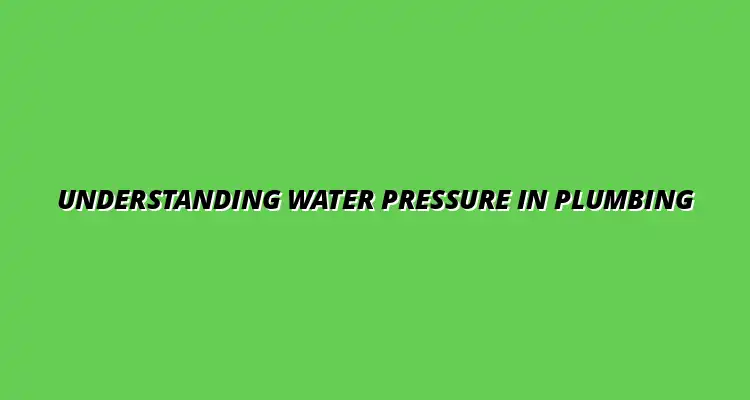
- Plumbing Basics
- Feb 05
2025-01-12
Water pressure is a crucial aspect of our daily lives, affecting everything from our showers to how well our toilets flush. When we turn on a faucet or step into the shower, we expect a steady flow of water. This flow is all thanks to the water pressure in our plumbing systems, which plays a vital role in providing us with the comfort and convenience we often take for granted!
In simple terms, water pressure is the force that pushes water through pipes and into our homes. Without it, we wouldn't have the reliable access to water needed for cooking, cleaning, and bathing. Understanding how water pressure works can help us appreciate its importance and identify any issues that arise. For a more comprehensive understanding of residential plumbing systems, check out this helpful resource.
Water pressure impacts many household activities that we often do every single day. Here are some examples of how it affects us:
As you can see, without proper water pressure, many daily tasks would become frustrating and time-consuming. It shows just how interconnected our lives are with this unseen force!
Each fixture in our homes relies on the right amount of water pressure to function efficiently. For example, a low flow from the faucet can make simple tasks like washing hands or brushing teeth feel tedious. On the other hand, high water pressure can lead to splashing and wasted water. Learning to save water through plumbing adjustments can also significantly impact your bills.
Finding the right balance helps ensure that all our fixtures work optimally. A well-regulated system not only improves functionality but can also lead to savings on water bills!
The level of water pressure directly affects our comfort at home. Imagine stepping into a shower with weak water flow—it's not a pleasant experience! A good shower requires a balanced pressure that allows for a satisfying wash without excessive force that can be uncomfortable.
This comfort extends beyond just showers. It includes any moment we use water in our homes, emphasizing the need for homeowners to be mindful of their plumbing systems. For instance, addressing issues like a running toilet promptly can make a big difference. Learn how to fix a running toilet easily here.
Understanding the basics of water pressure is essential for homeowners. Water pressure is defined as the force exerted by water as it moves through pipes, and it can be influenced by various factors, including location and pipe size. Recognizing this definition can help us appreciate the mechanics behind our plumbing systems.
Moreover, learning how water pressure is measured and regulated can empower us to maintain optimal conditions in our homes!
In plumbing, water pressure is typically measured in pounds per square inch (PSI). The right water pressure is crucial for appliances and fixtures to function correctly. For example, faucets require a minimum PSI to operate efficiently without wasting water. If you're experiencing issues with your kitchen sink, this guide on how to fix kitchen sink water pressure can be very helpful.
When we understand that water pressure is about both force and flow, we can better appreciate why it’s important to monitor and adjust it as needed!
Water pressure is measured using a pressure gauge, which indicates the PSI level in the plumbing system. Homeowners can easily check their water pressure with a simple gauge that attaches to a faucet.
Regulating water pressure can be done through the installation of pressure-reducing valves (PRVs) or by adjusting the municipal water supply, allowing for a more controlled flow. This regulation helps prevent damage from excessive pressure while ensuring a consistent supply for all fixtures!
Water pressure significantly affects the performance of different plumbing fixtures in our homes. Each fixture has its own optimal flow rate that depends on the pressure of the water supplied. Finding this balance is key for efficiency and effectiveness!
Understanding how various fixtures work with water pressure can help us make informed decisions when upgrading or maintaining our plumbing systems. Regular maintenance can also improve the lifespan of your water heater. Check out some tips for cleaning your water heater.
Faucets are designed to operate best within a specific pressure range. Too high or too low pressure can lead to issues like splashing or slow flow. Typically, a faucet should operate effectively between 40 to 60 PSI.
When pressure is within this range, you can enjoy a smooth flow for all tasks, from washing dishes to filling a glass of water!
Showerheads also depend on adequate water pressure for the best experience. A pressure between 2.5 and 3.0 GPM (gallons per minute) is usually ideal for showers. If the pressure is too low, you may find yourself standing under a dribble instead of enjoying a refreshing rinse!
On the flip side, excessive pressure may lead to uncomfortable sprays. Finding the right showerhead that matches your home’s water pressure can enhance your bathing experience. Addressing bathroom water pressure problems proactively can also prevent bigger issues. Here’s how to prevent bathroom water pressure problems.
Toilets rely on water pressure to flush waste effectively. If the pressure is too low, the toilet may not flush completely, leading to repeated flushes and wasted water. Ideally, toilets function best with water pressure around 20 to 60 PSI.
Regular maintenance and monitoring can help ensure that your toilet operates efficiently, saving water and providing a better user experience!
For any homeowner, knowing the ideal water pressure levels is crucial for maintaining a comfortable living environment. The recommended range is typically between 40 to 60 PSI, which ensures optimal function across all plumbing fixtures.
However, both high and low water pressure can cause a range of problems, making it important to keep an eye on pressure levels!
Here’s a quick overview of recommended water pressure ranges for different home situations:
Maintaining these levels ensures that all fixtures work smoothly without causing damage or discomfort!
High water pressure can lead to plumbing problems, including leaks, noisy pipes, and damage to appliances. Conversely, low water pressure can cause inefficient flushing in toilets and weak flow from faucets. Both situations can lead to increased water bills and wasted resources. If you need a plumber in Birmingham, especially in Tyseley, consider checking out this local plumbing service.
By keeping an eye on your water pressure and making necessary adjustments, you can prevent these issues from arising and ensure a well-functioning plumbing system!
Noticing something off with your water flow? You might be dealing with low water pressure in your home! Identifying symptoms early can help you address the issue before it becomes a bigger problem.
There are several signs that indicate you may be facing low water pressure:
Understanding the reasons behind low water pressure can help you tackle the problem effectively. Here are some common culprits:
High water pressure might seem like a good thing, but it can actually cause a lot of trouble! Your plumbing system is designed to handle specific pressure levels, and exceeding those can lead to serious issues.
Some risks associated with excessive water pressure include:
One effective way to manage high water pressure is by installing a pressure regulator. This device helps maintain a safe and consistent pressure level throughout your plumbing system. Here’s why it’s beneficial:
Just like any other system in your home, your plumbing needs regular attention to keep everything running smoothly. Here are some maintenance tips to consider for optimal water pressure:
Sometimes, water pressure problems can be tricky to diagnose and fix on your own. If you notice persistent issues, it might be time to call in a professional. Signs that you need expert help include:
Curious about water pressure management? Let’s tackle some common questions homeowners have:
The ideal water pressure for most homes falls between 40 to 60 psi (pounds per square inch). This range ensures efficient flow while avoiding stress on pipes. If you're outside this range, it may be time to consider adjustments.
Testing your water pressure is straightforward! You can use a water pressure gauge, which can be purchased at most hardware stores. Simply attach it to an outdoor spigot or a faucet and turn on the water!
Yes, there are several DIY solutions you can try:
Maintaining the right water pressure in your home is crucial for both comfort and efficiency. By understanding the common issues related to water pressure, you can take steps to ensure that your plumbing system operates smoothly.
Remember, monitoring your water pressure is key! Regular checks and maintenance can save you from larger plumbing headaches down the line.
Staying ahead of plumbing issues means being proactive. Regular inspections and upkeep can prevent small problems from becoming big ones!
It’s easy to forget about plumbing until something goes wrong. Schedule regular inspections to keep your system in top shape!
There are many resources available for homeowners looking to learn more about plumbing maintenance. Websites, local workshops, or even consultations with professional plumbers can provide valuable insights.
